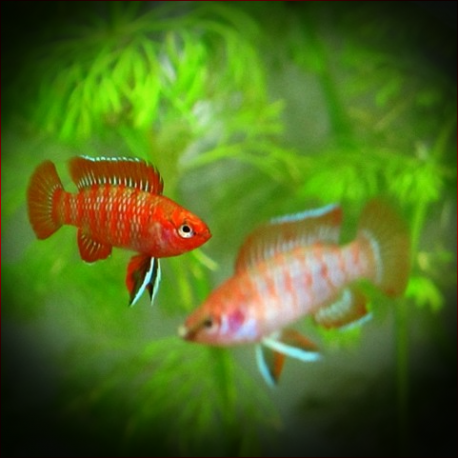More info
Datasheet
| Minimum Tank Size | 40 litres / 10.57 US gallons |
| Maximum Size | 2.0cm / 0.79inches |
| Temperature | 18°C / 64.40°F - 26°C / 78.80°F |
| Hardness | 1.01dgH / 18ppm - 15.02dgH / 268ppm |
| pH | 6.5-8.5 |
General Description
The Scarlet Badis (Dario dario) is a diminutive percoid fish, recognized in the aquarium trade for its vibrant hues and small size, making it a favored choice for nano tanks. It exhibits a distinguishing feature where males flaunt seven shimmering blue vertical bars on their flanks, setting them apart from other species within the genus.
Aquarium Setup
To ensure the well-being of Scarlet Badis, a 40-liter tank or larger is recommended, with meticulous attention to a structured layout offering ample hiding spots. A soft substrate is preferred, though fine-grade gravel is acceptable. Suitable plant choices comprise Cryptocoryne spp., Microsorum, Anubias, and Taxiphyllum species; the latter aids as an ideal spawning substrate. Additional elements like driftwood branches, floating plants, and leaf litter can enrich the setup for these fish.
Behaviour
These Badis are characterized by a laid-back demeanor, being easily intimidated by larger or more aggressive tankmates. They are best kept solitary or in the company of small pelagic species. In congested setups, male Scarlet Badis can display aggression towards each other, necessitating careful planning if a community tank is desired. Adequate space and well-distributed caves can assist in preventing territorial conflicts amongst males.
Feeding and Diet
Scarlet Badis are micropredators in the wild, preying on small aquatic crustaceans, insect larvae, and zooplankton. In captivity, they thrive on a diet of small live or frozen foods such as Artemia nauplii, Daphnia, grindal worms, micro-worms, and banana worms. Notably, feeding them chironomid larvae (bloodworm) or Tubifex should be avoided to deter obesity and potential health issues.
Reproduction & Dimorphism
During reproduction, Scarlet Badis adopt a substrate-spawning strategy and form temporary pair bonds. Males exhibit vibrant colors and territorial behavior to court females. After spawning, the male assumes responsibility for protecting the eggs. Females are smaller, less colorful, and sport a stouter body shape compared to males. To optimize fry survival, separating the adults or transferring the fry to a safe environment is recommended.
Habitat and Distribution
Inhabiting shallow streams with clear waters, sandy or gravelly substrates, and dense aquatic vegetation, Scarlet Badis are primarily found in tributaries draining into the Brahmaputra River in India, extending potentially into Bhutan. They coexist with other species like Badis blosyrus and B. kanabos in their native habitats, highlighting their ecological niche and interactions within the aquatic ecosystem.

